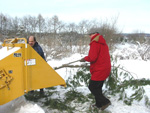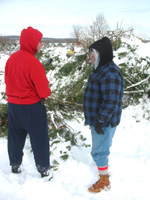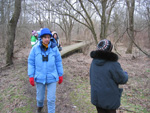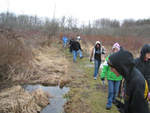Posted on Monday, January 31, 2011
When February enters the calendar, we at the Field Station automatically think about properly disposing of used Christmas trees and focusing on the Great Backyard Bird Count! Like clockwork, those events will happen February 12 and 19, respectively. They are fun, educational, useful and open to "town and gown."
For us, hunkered down in snow, February is a transitional month. In ancient Rome, Februarius was the "Month of Purification" and, history tells us, great festivities were held to reestablish the empire's focus on righteous living. Hey! Not bad for folks whose vocabulary did not include the word "green." So, when the temperatures go up and down, snow falls or not, and we no longer have use for those decorated trees in our homes, we can focus on righteous living, just like the Romans! And, similarly, when our feathered friends come to our feeders and new migrants begin to show up, we need to do the right thing: identify and count them!
For the past 13 years we've collected used Christmas trees and turned them into chips that are environmentally useful. We'll do that again on Saturday, February 12, beginning at 9:30 a.m. This is a time for folk of the community and college to show up, cover their ears to protect from cold and noise . . . then move those Christmas trees through the chipper. As February a year ago proved, we do this regardless of the weather! On the previous night, February 6, 2010, over a foot of snow dumped on us. Chipping went forward, though somewhat abbreviated.
Dress for the weather and come for a festival of righteous living! We'll provide ear and eye protection, a bonfire, cookies, something warm to drink . . . and the trees! Stay as long as you wish or until the job is done.
One week later we will shift from Christmas trees to birds. Our participation in the Great Backyard Bird Count has been ongoing for a decade, albeit with less formal attention than we are now giving it. On Saturday, February 19, beginning at 9:30 a.m. we will gather birders and wanna-bees in the yard of the Field Station for a bird walk! Dr. Kerri Cornell Duerr, newly appointed assistant professor of biology at Westminster, and her husband, Dr. Adam Duerr, assistant research professor at the College of William and Mary, will be our GBBC bird guides for the morning. They are birders, for fun and professionally. They will give expert hints on how to identify birds of our area. We invite community friends, college students and staff and anyone else who can make time for participating in a worthwhile program for birds . . . and for us. We will provide some binoculars, spotting scopes, field guides and the bird experts. Nature will surely provide the birds!
After the bird walk that begins near well-stocked bird feeders and continues along the Frey Nature Trail, we'll retreat to the Nature Center for hot chocolate and explanation of how to report species we've observed by computer to the Cornell University Lab of Ornithology and the National Audubon Society. We report by zip code and, in turn, can see what other birders of our region and state have reported. This is an international festival involving all 50 states and the provinces of Canada.
With a bit of maneuvering we can track bird species as they begin their annual migratory flights back to our area. Do you know where ruby-throat hummingbirds were spotted in February? The web site, http://www.birdsource.org/gbbc/whycount.html can help you find out! And we can check to see which species have been reported by other birders of our zip code this year, last year and even before that. In 2010, bird watcher posted 797 sightings of 32 bird species in our zip code!
Anyone can participate, from beginning bird watchers to experts. If you cannot come to the Field Station on the 19th, you can spot birds from your own backyard or field. It takes as little as 15 minutes on one day, or you can count for as long as you like each day of the event. It's free, fun, and easy, and it helps the birds.
How are the accumulated data used? Scientists and bird enthusiasts can learn a lot by knowing where the birds are. Bird populations are dynamic; they are constantly in flux as we noted this winter in the news on some massive bird die-offs. No single scientist or team of scientists could hope to document the complex distribution and movements of so many species in such a short time.
For our February 19 bird walk, we've invited children in the Bear Tree Connections environmental club and their parents to join us. Remember, everyone is welcome and the out-of-doors is one of the best places to celebrate Februarius, the "Month of Purification."
Clarence Harms, Director
Field Station
724-946-6001
harmsc@westminster.edu



